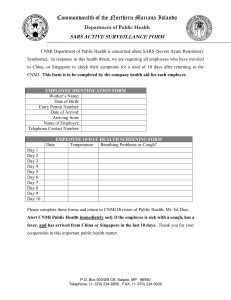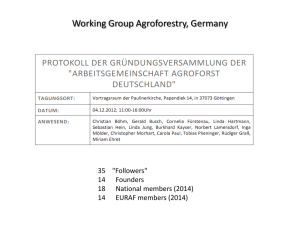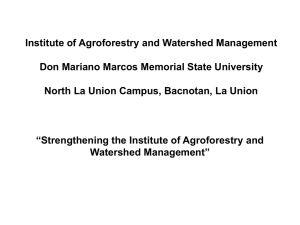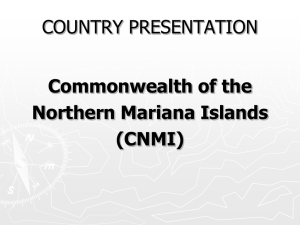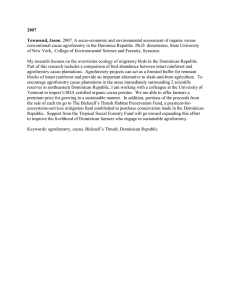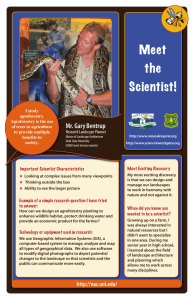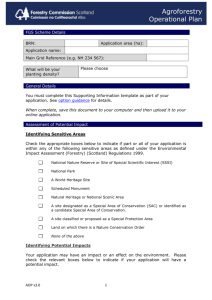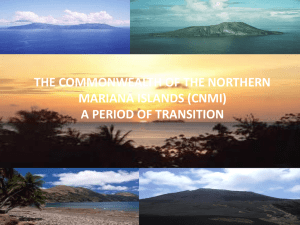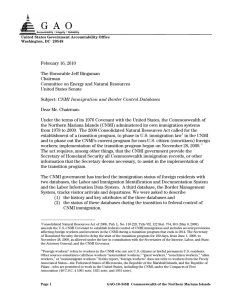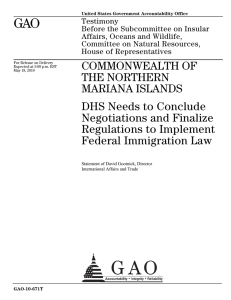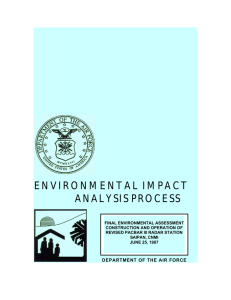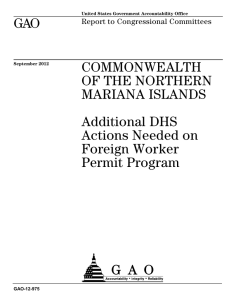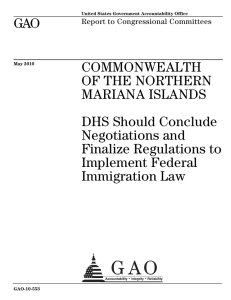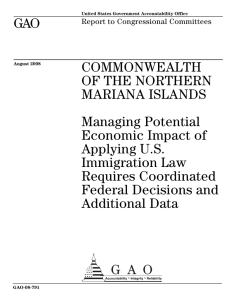Agroforestry Programs and Issues in the Northern Marianas Islands 1 Anthony Paul Tudela
advertisement
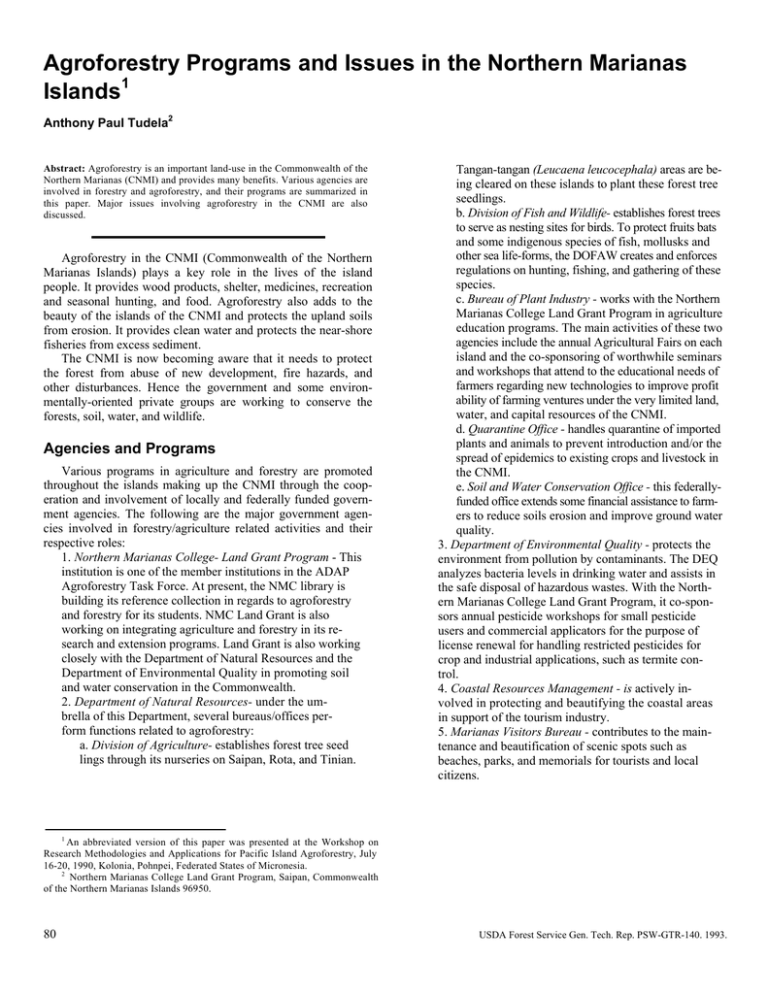
Agroforestry Programs and Issues in the Northern Marianas Islands1 Anthony Paul Tudela2 Abstract: Agroforestry is an important land-use in the Commonwealth of the Northern Marianas (CNMI) and provides many benefits. Various agencies are involved in forestry and agroforestry, and their programs are summarized in this paper. Major issues involving agroforestry in the CNMI are also discussed. Agroforestry in the CNMI (Commonwealth of the Northern Marianas Islands) plays a key role in the lives of the island people. It provides wood products, shelter, medicines, recreation and seasonal hunting, and food. Agroforestry also adds to the beauty of the islands of the CNMI and protects the upland soils from erosion. It provides clean water and protects the near-shore fisheries from excess sediment. The CNMI is now becoming aware that it needs to protect the forest from abuse of new development, fire hazards, and other disturbances. Hence the government and some environmentally-oriented private groups are working to conserve the forests, soil, water, and wildlife. Agencies and Programs Various programs in agriculture and forestry are promoted throughout the islands making up the CNMI through the cooperation and involvement of locally and federally funded government agencies. The following are the major government agencies involved in forestry/agriculture related activities and their respective roles: 1. Northern Marianas College- Land Grant Program - This institution is one of the member institutions in the ADAP Agroforestry Task Force. At present, the NMC library is building its reference collection in regards to agroforestry and forestry for its students. NMC Land Grant is also working on integrating agriculture and forestry in its research and extension programs. Land Grant is also working closely with the Department of Natural Resources and the Department of Environmental Quality in promoting soil and water conservation in the Commonwealth. 2. Department of Natural Resources- under the umbrella of this Department, several bureaus/offices perform functions related to agroforestry: a. Division of Agriculture- establishes forest tree seed lings through its nurseries on Saipan, Rota, and Tinian. Tangan-tangan (Leucaena leucocephala) areas are being cleared on these islands to plant these forest tree seedlings. b. Division of Fish and Wildlife- establishes forest trees to serve as nesting sites for birds. To protect fruits bats and some indigenous species of fish, mollusks and other sea life-forms, the DOFAW creates and enforces regulations on hunting, fishing, and gathering of these species. c. Bureau of Plant Industry - works with the Northern Marianas College Land Grant Program in agriculture education programs. The main activities of these two agencies include the annual Agricultural Fairs on each island and the co-sponsoring of worthwhile seminars and workshops that attend to the educational needs of farmers regarding new technologies to improve profit ability of farming ventures under the very limited land, water, and capital resources of the CNMI. d. Quarantine Office - handles quarantine of imported plants and animals to prevent introduction and/or the spread of epidemics to existing crops and livestock in the CNMI. e. Soil and Water Conservation Office - this federallyfunded office extends some financial assistance to farmers to reduce soils erosion and improve ground water quality. 3. Department of Environmental Quality - protects the environment from pollution by contaminants. The DEQ analyzes bacteria levels in drinking water and assists in the safe disposal of hazardous wastes. With the Northern Marianas College Land Grant Program, it co-sponsors annual pesticide workshops for small pesticide users and commercial applicators for the purpose of license renewal for handling restricted pesticides for crop and industrial applications, such as termite control. 4. Coastal Resources Management - is actively involved in protecting and beautifying the coastal areas in support of the tourism industry. 5. Marianas Visitors Bureau - contributes to the maintenance and beautification of scenic spots such as beaches, parks, and memorials for tourists and local citizens. 1 An abbreviated version of this paper was presented at the Workshop on Research Methodologies and Applications for Pacific Island Agroforestry, July 16-20, 1990, Kolonia, Pohnpei, Federated States of Micronesia. 2 Northern Marianas College Land Grant Program, Saipan, Commonwealth of the Northern Marianas Islands 96950. 80 USDA Forest Service Gen. Tech. Rep. PSW-GTR-140. 1993. Issues and Concerns Conflicts in the management of agroforestry resources do exist in the CNMI. One example is the conflict between concerned individuals and government entities about the disposition of public land at Kagman, Saipan for development of a golf course. This project would cover the Kagman Watershed Project that was to initiate engineering work in 1991. This watershed project is very valuable to the CNMI since it will assist in the solution of soil erosion, flooding, and irrigation―common problems on Saipan. Due to rapid development leading to the conversion of agricultural and residential land to commercial purposes, e.g., garment factories, zoning of agricultural and residential use USDA Forest Service Gen. Tech. Rep. PSW-GTR-140. 1993. lands has been proposed. However, so far this effort has not been successful due to the resistance of various affected groups. Fire causes many problems in the maintenance of forests for natural habitat for birds and other wildlife. It also contributes to erosion and the degradation of soil fertility. Also, indigenous plants utilized as medicine by local people are destroyed. Recommendations Increased educational efforts need to be made to create public awareness about their responsibilities and contributions to the beautification and maintenance of stable agroforestry systems in this small chain of islands in the American Pacific. 81
